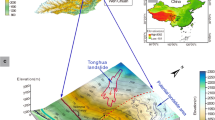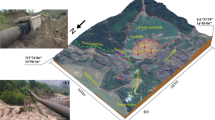Abstract
On Oct. 10 and Nov. 3, 2018, two landslides, i.e., the “10.10” and “11.3” rockslides, occurred successively at Baige Village, Jiangda County, Tibetan Autonomous Region, P. R. China. The two landslides are located in the upper reaches of the Jinsha River and both dammed the river. Immediately since the slides, the authors have been working on the slides and help disaster reduction. Based on the data collected by April 2020, this paper is aimed at clarifying the geological condition of the slides and at explaining why the slides occurred and what the whole sliding process was. Conclusions are summarized as follows. First, the two landslides occurred in the suture belt of the Jinsha River and the rocks are composed of tectonic mélange slices of mainly gneiss intermingled with carboniferous slate and marble and with intruded serpentine and granite porphyry. The gneiss generally bears a schistosity plane with an averaged attitude of N47° W/47°, dipping into the slope. Secondly, long-term geomorphological evolution of the bank slope due to river incision contributed to the progressive slope deformation for the development of the “10.10” rockslide. No preferential joints exist in the slope, but alteration and weathering played important roles in its occurrences. Rainfall and earthquakes may also accelerate its deformation. Thirdly, the “10.10” rockslide is of high-speed wedge-like slope failure with a high-position and a high-shear outlet. Its sliding and deposition process demonstrate special features as initial speed, collision between debris, surging waterjet, and second slipping. Fourthly, the whole process of the “10.10” rockslide can be divided into 6 steps, i.e., startup of the major sliding and sliding resistance zones, sliding initiation of the trailing zone, formation of debris-eroded zones, collision of debris and triggering waterjet and mist, secondary slip of the landslide dam, and surface flush in the deposition area. The estimated speed may reach as high as 67 m/s. Fifthly, the “11.3” rockslide follows a different mode, i.e., wedge cleaving effect. And finally, the cracked zones still have the risk to constitute a potential landslide and to dam the river again.





















Similar content being viewed by others
Data availability
All data, models, and code generated or used during the study appear in the submitted article.
Code availability
Not applicable.
References
Chen Y, Zhou F, Feng Y, Xia Y (1992) Breach of a naturally embanked dam on Yalong river. Can J Civ Eng 19:811–818
Chen J, Dai F, Lv T, Cui Z (2013) Holocene landslide-dammed lake deposits in the Upper Jinsha River, SE Tibetan Plateau and their ages. Quat Int 298:107–113
Chen J, Zhou W, Cui Z, Li W, Wu S, Ma J (2018) Formation process of a large paleolandslide-dammed lake at Xuelongnang in the upper Jinsha River, SE Tibetan Plateau: constraints from OSL and C-14 dating. Landslides 15:2399–2412
Chen J, Cui Z, Liu C, Zhou W, Chen R (2019) Meso/micro-texture analysis of the landslide-dam outburst sediments in the Upper Jinsha River, SE Tibetan Plateau. Geol Croatica 72:81–91
Chen Z, Zhang Q, Chen S, Wang L, Zhou X (2020) Evaluation of barrier lake breach floods: insights from recent case studies in China. Wiley Interdiscip Rev-Water 7. https://doi.org/10.1002/wat2.1408
Dai F, Lee C, Deng J, Tham L (2005) The 1786 earthquake-triggered landslide dam and subsequent dam-break flood on the Dadu River, southwestern China. Geomorphology 65:205–221
Deng H, Wu L, Huang R, Guo X, He Q (2017) Formation of the Siwanli ancient landslide in the Dadu River, China. Landslides 14:385–394
Fan X, Xu Q, Alonso-Rodriguez A, Subramanian S, Li W, Zheng G, Dong X, Huang R (2019) Successive landsliding and damming of the Jinsha River in eastern Tibet, China: prime investigation, early warning, and emergency response. Landslides 16:1003–1020
Fan X, Yang F, Subramanian SS, Xu Q, Feng Z, Mavrouli O, Peng M, Ouyang C, Jansen J, Huang R (2020) Prediction of a multi-hazard chain by an integrated numerical simulation approach: the Baige landslide, Jinsha River, China. Landslides 17:147–164
Li H, Qi S, Chen H, Liao H, Cui Y, Zhou J (2019) Mass movement and formation process analysis of the two sequential landslide dam events in Jinsha River, Southwest China. Landslides 16:2247–2258
Li M, Zhang L, Ding C, Li W, Luo H, Liao M, Xu Q (2020a) Retrieval of historical surface displacements of the Baige landslide from time-series SAR observations for retrospective analysis of the collapse event. Remote Sens Environ 240. https://doi.org/10.1016/j.rse.2020.111695
Li Y, Jiao Q, Hu X, Li Z, Li B, Zhang J, Jiang W, Luo Y, Li Q, Ba R (2020b) Detecting the slope movement after the 2018 Baige Landslides based on ground-based and space-borne radar observations. Int J Appl Earth Obs Geoinf 84. https://doi.org/10.1016/j.jag.2019.101949
Liang G, Wang Z, Zhang G, Wu L (2019) Two huge landslides that took place in quick succession within a month at the same location of Jinsha River. Landslides 16:1059–1062
Liu X, Zhao C, Zhang Q, Lu Z, Li Z (2020) Deformation of the Baige landslide, Tibet, China, revealed through the integration of cross-platform ALOS/PALSAR-1 and ALOS/PALSAR-2 SAR observations. Geophys Res Lett 47. https://doi.org/10.1029/2019gl086142
Ma J, Chen J, Cui Z, Zhou W, Liu C, Guo P, Shi Q (2018) Sedimentary evidence of outburst deposits induced by the Diexi paleo landslide-dammed lake of the upper Minjiang River in China. Quat Int 464:460–481
Min H, Deng J, Wei J, Zhang Q, Zou J, Zhou Z (2005) Slope safety control during mining below a landslide. Sci China Ser E 48(Supp):47–52
Ouyang C, An H, Zhou S, Wang Z, Su P, Wang D, Cheng D, She J (2019) Insights from the failure and dynamic characteristics of two sequential landslides at Baige village along the Jinsha River, China. Landslides 16:1397–1414
Scheidegger A (1973) On the prediction of the reach and velocity of catastrophic landslides. Rock Mech 5(4):231–236
Tian S, Chen N, Wu H, Yang C, Zhong Z, Rahmanet M (2020) New insights into the occurrence of the Baige landslide along the Jinsha River in Tibet. Landslides 18:1207–1216
Wang P, Chen J, Dai F, Long W, Xu C, Sun J, Cui Z (2014) Chronology of relict lake deposits around the Suwalongpaleolandslide in the upper Jinsha River, SE Tibetan Plateau: Implications to Holocene tectonic perturbations. Geomorphology 217:193–203
Wang W, Yin Y, Zhu S, Wang L, Zhang N, Zhao R (2019a) Investigation and numerical modeling of the overloading-induced catastrophic rockslide avalanche in Baige, Tibet, China. Bull Eng Geol Environ 79:1765–1779
Wang Y, Wu LZ, Gu J (2019b) Process analysis of the Moxi earthquake-induced Lantianwan landslide in the Dadu River, China. Bull Eng Geol Environ 78:4731–4742
Wei Y, Wang X, Sheng M, Zhou Z, Yuan Y (2015) Reproduction of the sedimentary disturbance phenomenon of the Diexi ancient landslide-dammed lake under earthquake. J Mt Sci 12:1181–1188
Wu Y, Niu R, Lu Z (2019) A fast monitor and real time early warning system for landslides in the Baige landslide damming event, Tibet. China Nat Hazards Earth Syst Sci Discuss. https://doi.org/10.5194/nhess-2019-48
Yang W, Wang Y, Wang Y, Ma C, Ma Y (2019) Retrospective deformation of the Baige landslide using optical remote sensing images. Landslides 17:659–668
Zhang Y, Zhao X, Lan H, Xiong T (2011) A Pleistocene landslide-dammed lake, Jinsha River, Yunnan, China. Quat Int 233:72–80
Zhang L, Xiao T, He J, Chen C (2019a) Erosion-based analysis of breaching of Baige landslide dams on the Jinsha River, China, in 2018. Landslides 16:1965–1979
Zhang Z, He S, Liu W, Liang H, Yan S, Deng Y, Bai X, Chen Z (2019b) Source characteristics and dynamics of the October 2018 Baige landslide revealed by broadband seismograms. Landslides 16:777–785
Zhao S, Chigira M, Wu X (2019) Gigantic rockslides induced by fluvial incision in the Diexi area along the eastern margin of the Tibetan Plateau. Geomorphology 338:27–42
Acknowledgements
Thanks should be given to our partners from Sichuan Huadi Construction Engineering Limited, Tibetan Geo-environmental Monitoring Center, Shenzhen Baidou Information Technology Corporation Limited, and 915 Geological Investigation Corporation Limited.
Funding
This study was financially supported by National Key R&D Program of China (2018YFC15050006) and the Second Tibetan Plateau Scientific Expedition and Research Program (2019QZKK0905). The support from the Natural Resources Bureau of Changdu City and Tibetan Autonomous Region, Sichuan Bureau of Surveying, Mapping and Geoinformation, China Renewable Energy Engineering Institute (CREEI), is greatly appreciated.
Author information
Authors and Affiliations
Contributions
All the authors participated in the field work and related discussion, Chen and Deng prepared the draft of this manuscript, Gao and Zhao helped to provide most of drawings, and Zhao also helped to polish the draft.
Corresponding author
Ethics declarations
Competing interests
The authors declare that they have no known competing financial interests or personal relationships that could have appeared to influence the work reported in this paper.
Rights and permissions
About this article
Cite this article
Chen, F., Gao, Y., Zhao, S. et al. Kinematic process and mechanism of the two slope failures at Baige Village in the upper reaches of the Jinsha River, China. Bull Eng Geol Environ 80, 3475–3493 (2021). https://doi.org/10.1007/s10064-021-02146-0
Received:
Accepted:
Published:
Issue Date:
DOI: https://doi.org/10.1007/s10064-021-02146-0




